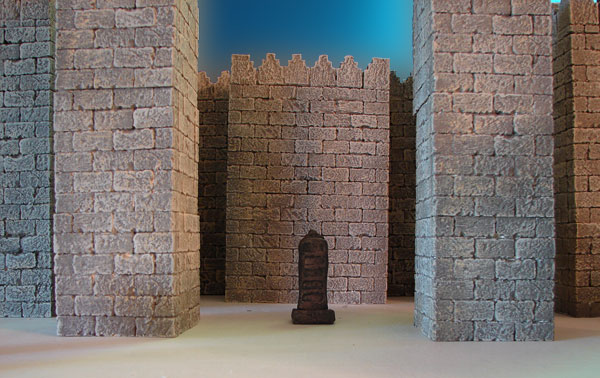|
|
|
 |
The Bible
Mentions King Jehu of Israel. The
Black Obelisk mentions Jehu, king of Israel in cuneiform script.
On the panel Jehu is bowing before Shalmaneser III, king of Assyria
and presenting him with gifts. The Jehu Relief on the Black
Obelisk is the only representation of an actual Hebrew king. It was discovered by archaeologists at
the site of Nimrud in Northern
Iraq. The Bible
mentions Jehu by name in 2 Kings 10:31. Jehu is the king who
ordered the death of Jezebel in the Bible. |
This miniature replica is of the Black
Obelisk of Shalmaneser III. The original is made of black limestone and
stands 7 feet tall. It was discovered by the late Austen Henry Layard in
1845 at the palace of Shalmaneser III in ancient Nimrud (Calah). The 4
sides of the obelisk contain panels that reveal the kings exploits. One
of the panels depicts the Hebrew king Jehu, or possibly one of his
servants, bringing gifts to Shalmaneser and kneeling at his feet. The inscription above it reads:
"The tribute of Jehu, son of Omri,
silver, gold, bowls of gold, chalices of gold, cups of gold, vases of
gold, lead, a sceptre for the king, and spear-shafts, I have
received."
2 Kings 10:31 -
"But Jehu took no heed to walk in the law of the LORD God
of Israel with all his heart: for he departed not from the sins of
Jeroboam, which made Israel to sin."

This map shows the primary capitals of the Neo-Assyrian Empire
Museum Images
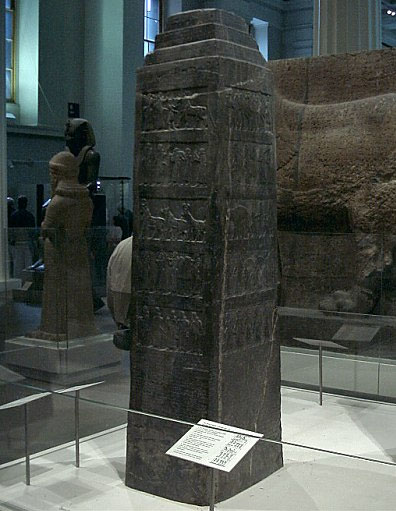
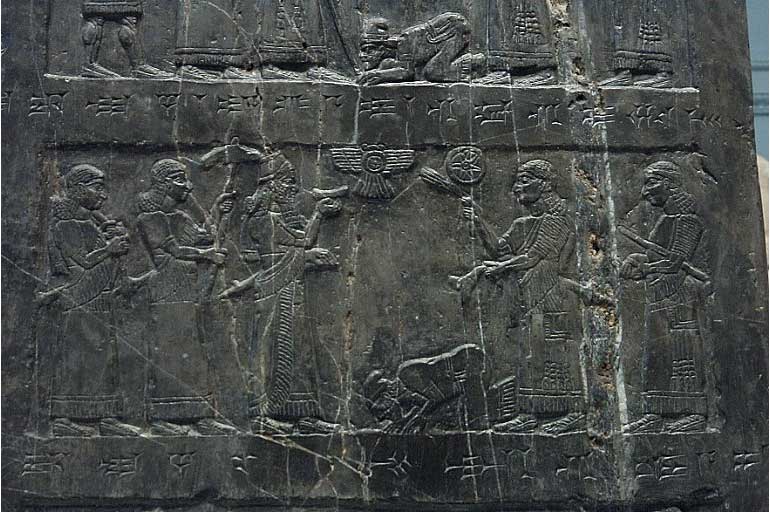
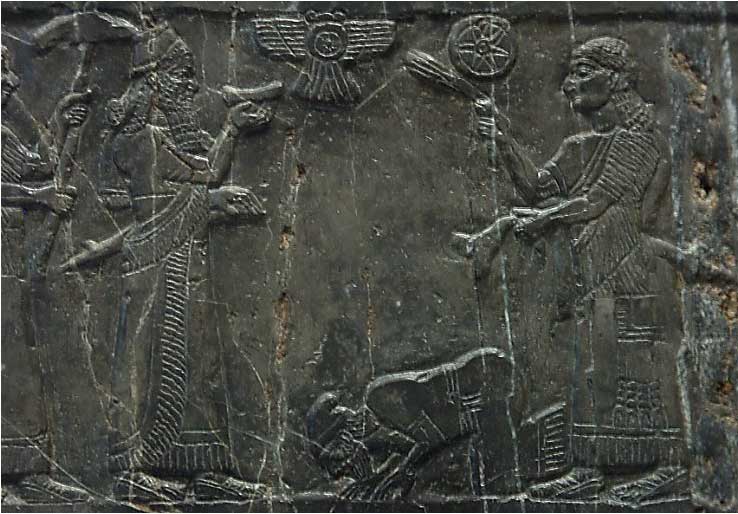
Material - Black Limestone Obelisk
Neo Assyrian
Date: 858-824 BC
Height: 197.85 cm (77.8937008 inches)
Width: 45.08 cm (17.7480315 inches)
Depth:
Nimrud (ancient Calah), northern Iraq
Excavated by: Henry Layard 1845-1849
Location: British Museum, London

British Museum Excerpt
The Black Obelisk of Shalmaneser III
Neo-Assyrian, 858-824 BC
From Nimrud (ancient Kalhu), northern Iraq
The military achievements of an Assyrian king
The archaeologist Henry Layard discovered this black limestone obelisk
in 1846 during his excavations of the site of Kalhu, the ancient
Assyrian capital. It was erected as a public monument in 825 BC at a
time of civil war. The relief sculptures glorify the achievements of
King Shalmaneser III (reigned 858-824 BC) and his chief minister. It
lists their military campaigns of thirty-one years and the tribute they
exacted from their neighbours: including camels, monkeys, an elephant
and a rhinoceros. Assyrian kings often collected exotic animals and
plants as an expression of their power.
There are five scenes of tribute, each of which occupies four panels
round the face of the obelisk and is identified by a line of cuneiform
script above the panel. From top to bottom they are:
Sua of Gilzanu (in north-west Iran)
Jehu of Bit Omri (ancient northern Israel)
An unnamed ruler of Musri (probably Egypt)
Marduk-apil-usur of Suhi (middle Euphrates, Syria and Iraq)
Qalparunda of Patin (Antakya region of Turkey)
The second register from the top includes the earliest surviving picture
of an Israelite: the Biblical Jehu, king of Israel, brought or sent his
tribute in around 841 BC. Ahab, son of Omri, king of Israel, had lost
his life in battle a few years previously, fighting against the king of
Damascus at Ramoth-Gilead (I Kings xxii. 29-36). His second son (Joram)
was succeeded by Jehu, a usurper, who broke the alliances with Phoenicia
and Judah, and submitted to Assyria. The caption above the scene,
written in Assyrian cuneiform, can be translated
The tribute of Jehu, son of Omri: I received from him silver, gold, a
golden bowl, a golden vase with pointed bottom, golden tumblers, golden
buckets, tin, a staff for a king [and] spears.
Height: 197.85 cm
Width: 45.08 cm
Excavated by A.H. Layard
ANE 118885
Room 6, Assyrian sculpture
British Museum Page
===========================
Shalmaneser III and Israel
Shalmaneser III came to the throne of Assyria in
860 BC and reigned until 825 BC. He was the son of the mighty conqueror
Ashurnasirpal II and the first Assyrian king to go to war with Israel.
He created massive building projects and expanded the land of Assyria
into an empire.
Information about the Jehu Relief on
the Black Obelisk
- Black Limestone Obelisk of king Shalmaneser
III of Assyria (841 BC).
- The obelisk has 5 panel scenes on eack of the 4 sides
- The panels are glorifying the achievements of the
king of Assyria
- The multiple panels show illustrations of all the nations bring
tribute
- There is a caption in cuneiform for each panel illustration
- The Jehu Panel is side A Row 2 on the Black Obelisk
- The Jehu Panel depicts king Jehu of Israel bowing before the king
of Assyria.
- This is the King Jehu of the Bible (2
Kings 9-10).
- Jehu is basically groveling in the dust before the king of Assyria
- This is the only representation of a Hebrew king from ancient times.
- This gives us some idea of Israelite
dress in old testament times.
- There are a band of 13 Israelites with precious gifts.
- King Shalmaneser is making a libation
- The symbols of the gods Assur (winged
sun disc) and Ishtar (star) are above
- Behind Shalmaneser are two officials holding a parasol and a club
- Some other nations include Iran, Egypt, Euphrates Valley, and Turkey
- The Black Obelisk stands 197 cm (6.5 feet) tall.
- Shalmeneser III reigned from 860-825 BC.
- The Black Obelisk is from the Neo-Assyrian Period (1000-612 BC).
- Excavated at the site of ancient Nimrud (Calah) in 1846.
- Shalmeneser III was the first Assyrian king to go to war with Israel.
- Ancient Nimrud was excavated by Austen Henry Layard of Britain around
1846.
- The Black Obelisk is currently at the British Museum.
- Nimrud (Kalhu) was Shalmeneser III's capital city (Northern Iraq).
Shalmaneser II Inscription
Shalmaneser, the great king, strong king, king of the world, king of
Assyria, son of Ashurnasirpal, the great king, strong king, king of the
world, king of Assyria, son of Tukulti-Ninurta, king of the world, king
of Assyria, construction of the ziggurat of Kalhu," -Shalmaneser III
Inscription
"Opposite the monarch two
grooms-in-waiting have taken up their stance, one waves a fan and a
censer, the other, carrying a scepter under his arm, has his hands
respectfully clasped in front of him. Then comes a bearded officer
with an attendant, leading a procession of 13 Israelites laden with
precious gifts for the Assyrian king. All the Israelites are
bearded, and wear peaked caps and bandeaux. A long robe with fringes
round the hem and a girdle, a long cloak with fringed end thrown over
the shoulder, and pointed shoes complete their outfit."
The Assyrian Empire
The first great military empire in ancient history
was the Assyrian Empire. By the time of Ashurnasirpal and Shalmaneser
III in the 9th century BC the Assyrians organized a mighty army of
nearly 200,000 soldiers. Their military strategy was unsurpassed up to
that time, and with the age of iron they were an unstoppable fighting
machine. They brought spearmen, archers, shieldmen, slingers, siege
engines, chariots, and a huge calvary into the battlefield. The mighty
Assyrians dominated the ancient world until they were crippled by the
God of Israel in the reign of Sennacherib. God raised up the Assyrians
to remove Israel out of his sight for their rebellion and idolatry, but
the Assyrians would also be punished also for their wicked ways. They
finally fell to the Medes and Babylonians in 612 BC and passed into
history.
 Assyrian Kings Mentioned in the Bible
Assyrian Kings Mentioned in the Bible
2 Kings 15:29 -
In the days of Pekah king of Israel, Tiglath
Pileser king
of Assyria came and took Ijon, Abel Beth Maacah, Janoah, Kedesh, Hazor,
Gilead, and Galilee, all the land of Naphtali; and he carried them
captive to Assyria.
2 Kings 15:19 - Pul the
king of Assyria came against the land, and Menahem gave Pul one thousand
talents of silver, that his hand might be with him to confirm the
kingdom in his hand.
2 Kings 18:9 -
And it came to pass in the fourth year of king Hezekiah, which [was] the
seventh year of Hoshea son of Elah king of Israel, that Shalmaneser king
of Assyria came up against Samaria, and besieged it.
Isaiah 20:1 -
In the year that Tartan came unto Ashdod, when Sargon the
king of Assyria sent him,) and fought against Ashdod, and took it;
2 Kings 19:16 -
LORD, bow down thine ear, and hear: open, LORD, thine eyes, and see: and
hear the words of Sennacherib,
which hath sent him to reproach the living God.
2 Kings 19:37 -
And it came to pass, as he was worshipping in the house of Nisroch his
god, that Adrammelech and Sharezer his sons smote him with the sword:
and they escaped into the land of Armenia. And Esarhaddon his
son reigned in his stead.
Ezra 4:10 - and the rest
of the nations whom the great and noble Asnapper brought
over, and set in the city of Samaria, and in the rest of the country
beyond the River, and so forth, wrote.
Assyrian Kings Names in Cuneiform
Archaeology
of Ancient Assyria
Timeline of Ancient Assyrian Kings
(During the Period of the Biblical Kings)
Assur-nasirpal II (885-860
B.C.) A cruel warrior king, he made Assyria into the most fierce
fighting machine of ancient world.
Shalmaneser III (860-825
B.C.) His reign was marked by almost constant war. He was the first
Assyrian king to come into conflict with Israel. King Ahab fought
against him, and king Jehu paid him tribute in 841 BC. His royal
inscriptions were more detailed and more numerous than any other king.
His building works were massive just like his father Assurnasirpal II.
See Shalmaneser
and the Black Obelisk.
Shamsi-Adad V (825-808
B.C.) Most of his reign was focused on Babylonia and his own internal
conflicts.
Adad-nirari III (808-783
B.C.) The little information about his reign mentions his building
projects at Calah and Nineveh, as well as a conflict at Der in Babylonia
and collecting tribute in Damascus, Syria.
Shalmaneser IV (783-771
B.C.) The limited knowledge of his reign reveal some conflicts in
Damascus and a period of decline in Assyria.
Assur-dayan III (771-753
B.C.) The little information about this ruler reveals Assyria being in a
period of decline.
Assur-nirari V (753-747
B.C.) There is very little information about his reign. The king of
Urartu boasted of a victory over this king of Assyria in an inscription.
Tiglath-pileser III (Pul)
(747-727 B.C.) He restored Assyria to a major world power. He is the "Pul"
mentioned in the Bible and the one who began to destroy Samaria, the
capital of the Northern Kingdom of Israel. He carried many away into
captivity. This captivity is mentioned in his own inscriptions, the
Babylonian Chronicle, and the Bible.
Shalmaneser V (727-722
B.C.) He besieged Samaria, the capital of the Northern Kingdom of
Israel. He died during the siege after imposing taxation on the holy
city (Asshur), and his son Sargon came to power.
Sargon II (722-705
B.C.) He completed the destruction of Samaria and the captivity of
Israel. He was also famous for his magnificent palace with his colossal
winged guardians.
Sennacherib (705-681
B.C.) He was the most famous of the Assyrian kings. He mentions the name
of Hezekiah on his prism during his war campaigns, he claimed to have
"Hezekiah captured in his own royal city (Jerusalem) like a caged bird."
His army was defeated at the gates of Jerusalem by the Angel of the
Lord. Sennacherib returned back to Nineveh and was killed violently by
his own son, as mentioned in the Babylonian Chronicle, The Bible, and
various other inscriptions. He also conquered Babylon.
Esar-haddon (681-668
B.C.) He rebuilt Babylon, invaded and conquered Egypt by crossing over
the Sinai Desert with Arab camels carrying water for his army, and was
one of Assyria's greatest kings. He died fighting Egypt.
Assur-banipal (668-626
B.C.) He destroyed the Thebes in Egypt and collected a great library,
innumerable clay tablets were found.
Assur-etil-ilani (626-607
B.C.) It was under his reign that the Assyrian Empire fell.
 Assyrian
annals mention contacts with some ten Hebrew kings: Omri, Ahab, Jehu,
Menahem, Hoshea, Pekah, Uzziah, Ahaz, Hezekiah, and Manasseh. Assyrian
annals mention contacts with some ten Hebrew kings: Omri, Ahab, Jehu,
Menahem, Hoshea, Pekah, Uzziah, Ahaz, Hezekiah, and Manasseh.
In the reign of Hoshea, king of Israel, Shalmaneser, king of
Assyria, twice invaded (2 Kings 17:3,5) the kingdom that remained, and
his successor Sargon II took Samaria in 722 BC, carrying away 27,290 of
the population as he tells in his Khorsabad Annals. Later Assyrian
kings, particularly Esarhaddon (681 BC - 668 BC), completed the task.
For More Info See:
Bible History Online
Map of the Land of Assyria
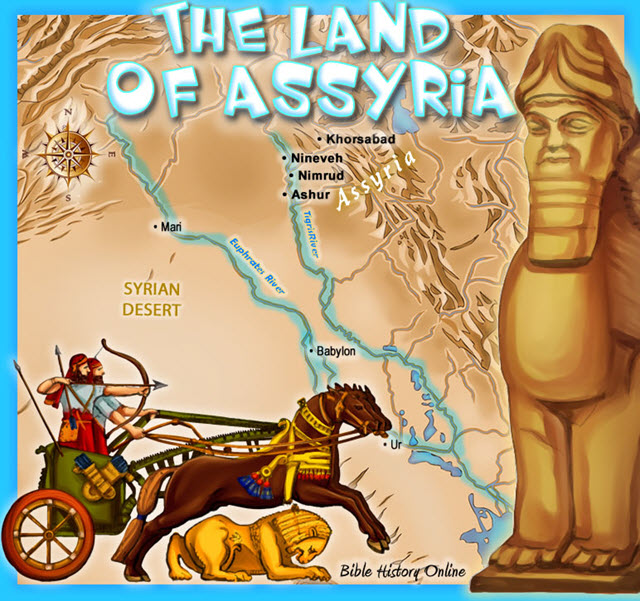
Kids Bible Maps
Primary Sources for Assyrian History
The Assyrian Annals. The scribes of the chief cities of the
Assyrians wrote the accounts of the king's military campaigns on
cuneiform tablets, and clay prisms or cylinders. The accounts are very
reliable, even though the accounts do not speak negatively of the
Assyrians and are meant to glorify the king. The annals also give much
detail to geography and Chronology. It is interesting how accurate the
Assyrians were with dates, they made use of an Assyrian Kings List or
the Eponym Canon.
The Assyrian Chronicles and Eponym Canon. The Assyrian scribes
organized their national events whether military, political or religious
every regnal year. The Babylonian Chronicles were structured the same
way. Assyrian records were kept very carefully, they took their dating
and their history seriously. They attached their record of events with
the solar year and with the name of an official who was known as the "limmu."
Their was a new limmu appointed every year. They recorded military,
political and religious events in every year and made references to
eclipses. The Assyrian records are highly dependable and allow Biblical
scholars a very accurate way of dating events and designating "eponyms"
for 244 year in Hebrew history, from 892-648 BC.
The Assyrian King List.
The Assyrian King List reveals a list of the kings of ancient
Assyria in chronological order, from the 2nd millennium BC to 609 BC. It
lists the name of the king, his father's name, the length of his reign,
and some great achievements.
Assyrian Sculptures. The limestone bas-reliefs discovered
from the palace walls of major Assyrian capital cities like Nineveh (Kuyunjik),
Nimrud (Calah), Khorsabad (Dur-Sharrukin), and the bronze bands on the
Balawat Gates reveal a wealth of history. The illustrative events were
carved be professional Assyrian artists like a modern day photographer
on the scene. The carvings reveal the military might and tactics of the
Assyrians, as well as the futility of those nations that defied their
might. These sculptures are on display in museums around the world, for
example: The British Museum in London, The Louvre in France, The Iraqi
Museum, and The Oriental Institute in Chicago.
The Bible. The Old Testament records the history of the Kingdoms
of Israel and Judah, along with the battles of other nations. It
includes the fall of the 10 tribes in northern kingdom of Israel in 722
BC by the Assyrians, as well as the
fall of the southern kingdom of Judah in 586 BC by Nebuchadnezzar of
Babylon. The Bible also records miraculous events surrounding people
like Elijah, and Jonah, as well as the slaying of 185,000 Assyrians at
Jerusalem by the Angel of the LORD. The events recorded in 2 Kings
generally agree with Assyrian and Babylonian sources. |
